In: Niagara Region

Barry Smith | What’s Your Stance? | 2024
June 29, 2024Barry Smith | What’s Your Stance? | 2024
Barry Smith’s exhibition What’s Your Stance? was on view at Mahtay Café & Lounge in downtown St. Catharines for the majority of the month of May 2024 and into early June. Smith’s exhibition was the 18th in my continuing series of shows in the space platforming visual artists of the Niagara Region that is soon to mark two years.
Smith is not – on social media or in life – shy about his own ‘stance’ and his own political views. I’ve known him for most of my time in Niagara, and the exhibition is a series of images of photographers taking photos that Smith has captured in the act. There’s a voyeurism to the work, but the nature of the installation in the downtown St. Catharines space also allows play and interaction between the ‘characters’ as they seem to be taking pictures of each other, or are looking at people and events unknown and unseen to us.
Smith’s statement : Everyone has their opinions. Whether it be in the social, political or religious sphere. Some are based on fact, some on faith, and some are emotional due to personal experiences, education and (sadly) social media.
We all have a point of view. Some are balanced, conservative or outright risky.
I see this in the way people take photographs. Some are amateurs, some hobbyists and others are professional – but everyone has their own stance.
What’s your stance?
To say we live in a time when contention and division between peoples’ respective stances is intense is an understatement. Smith, for example, is a vocal advocate for Palestine and against the ongoing genocide perpetuated by the state of Israel and her enablers on the international scene. In our shared community – and many, many others – this is a ‘stance’ many of us see as being a default one, while others choose to stand somewhere else….
I often see things – I choose to stand, in my interpretation – through the lens of the art world, both in Canada (that imaginary nation we live in) and the larger international discourses within that sphere.
With the current situation in the Middle East, fractures – splits that expose or exacerbate hypocrisy – are becoming harder to deny. The termination of Wanda Nanibush from her position at the AGO, for example, spearheaded by someone who will allude to how art should have a social conscience and challenge us, but ‘just not that way’, or more exactly NOT in a way they ‘disagree’ with is a fine example.
I’d offer another : as many of you know, I spent nearly two decades in Saskatchewan, a place rife with racism regarding Indigenous and Settler relations. I was deeply amused – and not surprised at all – at the hypocrisy of someone I had the lamentable experience to work with in the ARC spaces publishing an article with Galleries West, decrying what he saw as ‘rising antisemitism’ in the international art world. This same person was instrumental in attempting to silence and blackball me when I published numerous factual articles about the institutional racism at his employer, the University of Saskatchewan, and I thought when I saw his blinkered whining that perhaps he had begun to see that dehumanizing others is not something that can be contained to one space, and bleeds into others, especially when you legitimize it for your own ideology, thinking it is ‘unique.’
Recently I read an engaging article from ArtForum about the rise in protests in museums and in gallery spaces and the writer – Charlotte Kent – offered a number of ideas and writers that I’ve been researching since I read the piece about how cultural spaces are stakeholders and often consistent – if not eager – manufacturers of alibis for the status quo, whether that status quo be that only one ‘type’ of art is ‘actually art’ or that some people and ideas are simply a denkverbot (to paraphrase Žižek) : of them, ‘we’ are ‘prohibited to speak.’
But, as Kent asserts ‘Museums [and by extension what fills them, as art] have never not been political.’
…I suspect I told you more about ‘my stance’ with that tangential response to Smith’s work than about his work, but I also suspect Smith would be comfortable with that, in that I ‘answered’ his question.
Born in Scotland and raised in Niagara, Barry Smith has always had a flair for humour and wit which he often employs in the titles of his photographs and his compositions. A self taught photographer, Smith has found his own unique photographic style and approach, concerned with using natural light. Smith’s photographs come to life like a fresh painting on canvas.
A past St. Catharines Art Award nominee, Smith’s pictures can be found on display throughout Niagara at various art shows and galleries.
What’s Your Stance? A Selection of Photographs by Barry Smith was on view at Mahtay Café & Lounge in downtown St. Catharines in the Spring of 2024.
You can see more of his work at his IG here.
~ Bart Gazzola
Read More
Sandy Fairbairn | ART, Road Closed | Welland, April 5 2014
January 19, 2024Sandy Fairbairn | ART, Road Closed | Welland, April 5 2014
Four years ago, just as Covid – 19 was beginning to move across the world, an exhibition of Sandy Fairbain‘s artworks that I curated at AIH Studios in Welland opened. These selections from the photographer’s extensive archive were focused upon the city of Welland and were collectively titled Welland : Times Present Times Past. Originally planned to run from February 15th to March 15th 2020, lockdowns and access became an issue, but I take joy in a local writer describing it as one of the most important exhibitions in that city, of the decade. There were also works that acknowledged the major role that Welland played in the history of labour rights in Canada, that were more sculptural, but that’s a story for another time (or seek out the book Union Power : Struggle and Solidarity in Niagara that is a fine history of the space, before we acquiesced to the ‘dogma’ of ‘trickle down economics’ and the liars Mulroney, Thatcher and Reagan, ahem).
This image was one of the more unique ones in that show, differing formally from Fairbairn’s usual straight on shots of buildings and edifices, reminiscent of ‘mug shot architecture’, if you will. But perhaps it might be better described as ‘morgue’ photos, as when we hung the show there were many captures of the same space, from decade to decade, and many times the sites were now demolished and empty….
I must add that as COVID took hold, I was in Welland for a longer time than I had planned to be there, with Fairbairn’s exhibition, and with the vagaries of lockdown I got to know the city late at night or early in the morning, a sense of itself that is not the ‘official’ kind.
Conceptually, this image offers both amusement and cynicism simultaneously. As someone who is soon to mark a decade of being part of the cultural community of Niagara, I could also add that it has resonance in terms of endeavours both planned and aborted, envisioned and stuttered, that have defined [and deformed] the cultural landscape of not just the city of Welland, but the larger Niagara Region.
So like any fine artwork, my interpretation of it changes depending upon when I see it, and the experiences I bring to it, and thus it shifts just as I do (perhaps in tandem, perhaps in opposition). To flip back to a more literal meaning from a conceptual one, my own attitudes about art initiatives within the space of Niagara have also changed, and spurred my decision to feature this work.
One hopes and works to foster artistic and cultural initiatives but finds the road closed, if you will. There are a variety of talks about ‘cultural revitalization plans’ in Niagara, but as this is the space that let a nationally recognized public art gallery go, with barely a whimper and now ignorant celebration of the ’boutique hotel’ that has taken it’s place, I shall reserve my enthusiasm…..but, to offer a positive point as we end, the push to have an Art Gallery of Welland is also moving forward, slowly but surely, and that effort is not without reward. As Sandy Fairbairn grew up in Welland (oh, the stories he’s shared with me, that I enjoy and enlivened some of his images from the aforementioned AIH exhibition), that is a space that might, soon, host more of his photographs like this one.
Not all roads are closed forever.
More of Sandy Fairbairn’s work can be seen here and here.
~ Bart Gazzola
Read More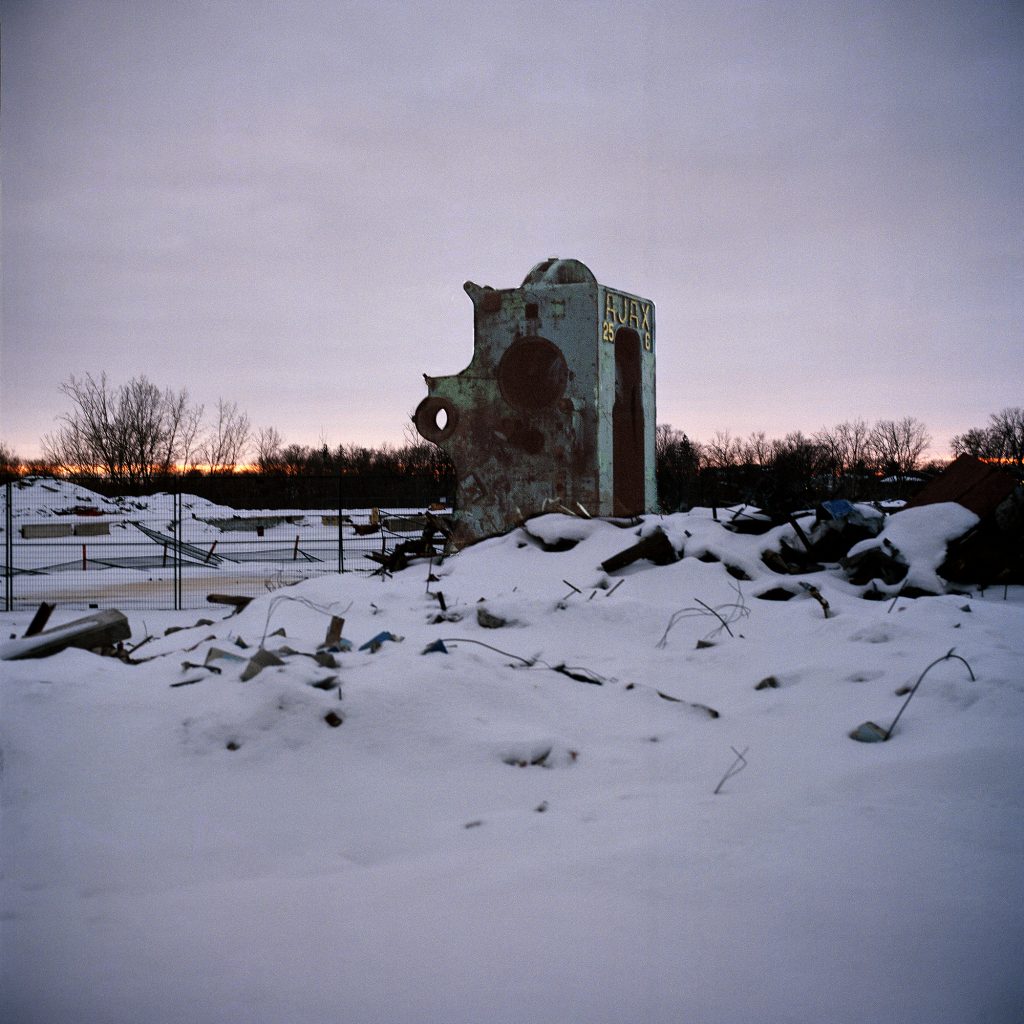
Julianna D’Intino | Connecting Rods: A Survey of Industry in the Niagara Region, 2015 – 2022
September 22, 2022Julianna D’Intino | Connecting Rods: A Survey of Industry in the Niagara Region, 2015 – 2022
To talk of the legacy of GM when you live in the city of St. Catharines is akin to how your tongue will always go to the gap in your teeth, seeking something that was there and now is not, leaving nothing behind but a perceptible absence you are unable to ignore.
Julianna D’Intino’s images, both moving and still – and I’ve been lucky enough to see several bodies of work she’s produced – often have a local focus, and in some ways she steps into that role of photographer as social historian. Often this involves her adjacent community in Niagara, exploring her own immediate heritage and circle. One such series can be seen here.
Connecting Rods: A Survey of Industry in the Niagara Region is a family story, as well as a local one. The ‘connection’ in the title of this series is not just a nod to an industrial interpretation, but also the families, communities and city that is part of a network that once had its epicenter in the abandoned wastelands D’Intino presents us with….and in her fine words about this series, D’Intino also draws connections to other areas with similar experience, such as with Atlas Steels or John Deere in Welland.
That potential for ‘nostalgia’ doesn’t mean what D’Intino is telling us is through rose – coloured glasses, nor does it gloss over the reality: her words about this work are as unflinching and honest – and engaging – as her photographs.
“This is but one personal case study in the myriad of lost industry of the Niagara Region. Would the return of the Niagara Region as a manufacturing hub provide a sustainable solution to the region’s economic woes? No, it would not. What is missing in the region is sufficient work at wages high enough to sustain a well-balanced life at the Niagara Region’s new inflated cost of living. The last time that such security was widespread was when manufacturing was a leading industry.”
The legacy of GM in St. Catharines is surely a contested narrative, with ground fertile for those from here – like D’Intino, or myself – to mine. It’s as rife as the industrial damage left behind at the site (an ongoing issue in civic politics here which has led to some grotesque and unsettling bedfellows), and there are differing opinions in play. Anna Szaflarski, for example, offers another perspective on this history here.
D’Intino’s site is here, and more images and D’Intino’s considered words about Connecting Rods can be found here.
~ Bart Gazzola
Read More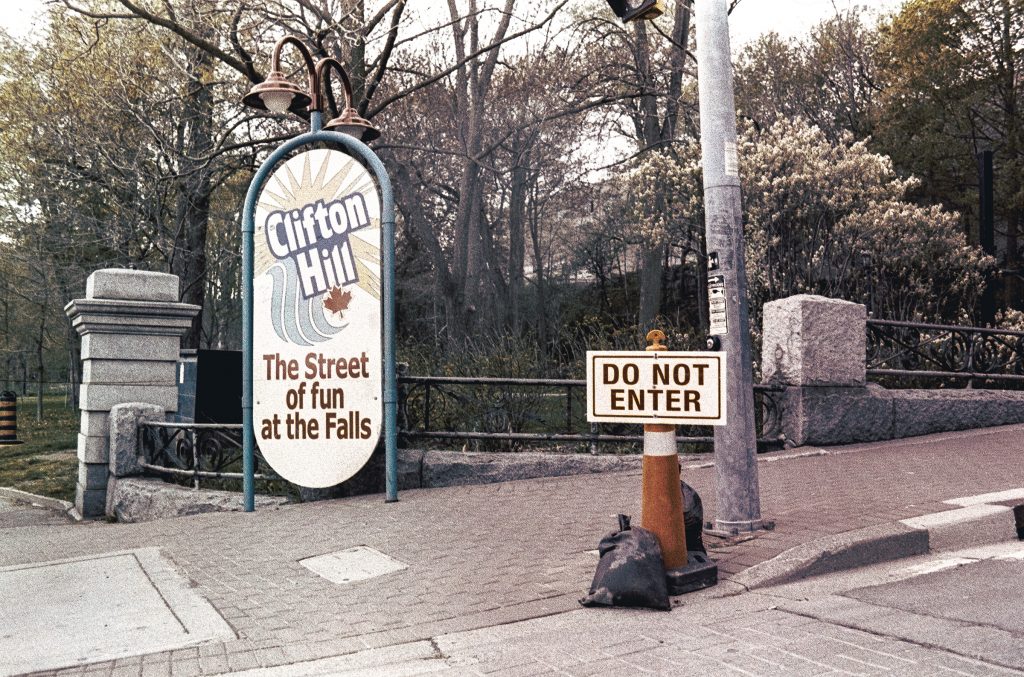
Necropolis | Jon Lepp
May 18, 2022Necropolis | Jon Lepp Necropolis | Jon Lepp, The Open for Business Series @deadendstories Photographs, [Virginia] Woolf claims, "are not an... Read More
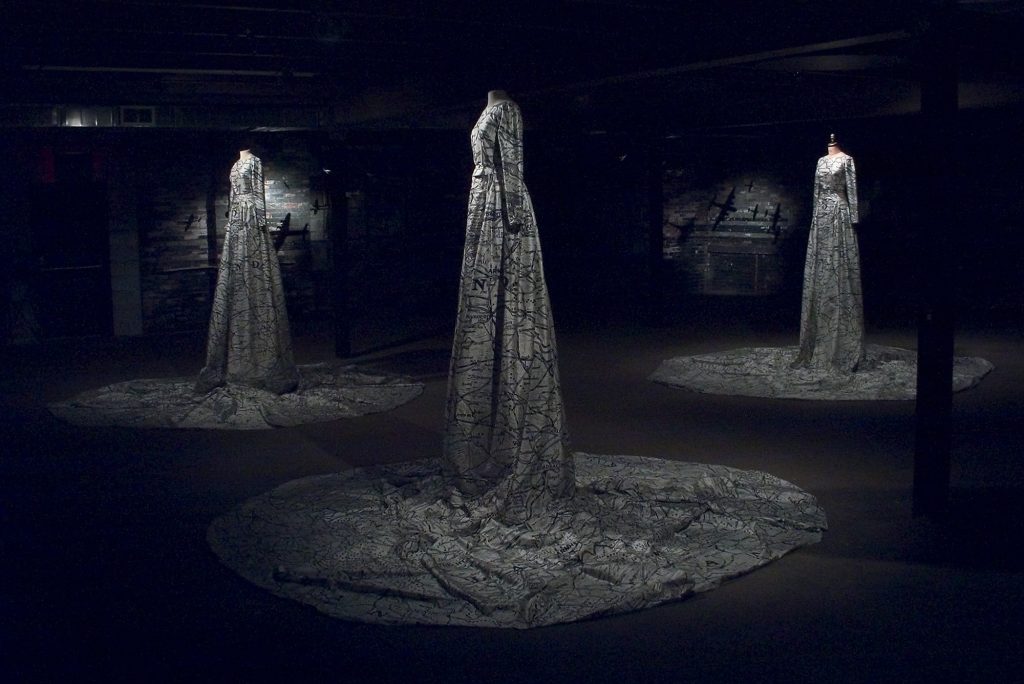
War Map Dress Trilogy | Carolyn Wren, 2003-2004
June 30, 2022Carolyn Wren | War Map Dress Trilogy, 2003-2004
(lino blocks, hand-printed on Dupont silk, thread, zippers, mannequins, model airplanes, black paint)
I encountered these towering figures during Wren’s retrospective exhibition Task At Hand at the now shuttered Rodman Hall Art Centre several years ago. Standing in the large back gallery space, the three female figures dominated the room, with the flow of their dresses spilling out from them, pooling around them on the gallery floor.
Visiting this show numerous times, I found that different ideas came to the fore with different interactions, from initial wonder to later, more critical consideration. When an artist / writer friend, Anna Szaflarski, visiting Niagara, came with me on one occasion, she saw the works in a very different light than I had, initially. Unsurprising, really, as when Szaflarski and I first met, it was around her exhibition at NAC about the historical detritus – or lack thereof – of General Motors’ legacy in St. Catharines, and I believe we connected over an irreverent honesty about history, the region, and the intersecting if conflicting stories of the place we both grew up in….
My reading had been informed by Wren’s own words, which are as follows: The ingenuity of Christopher Clayton Hutton’s invention of silk maps for the British Royal Air Force during World War II enabled pilots to use lightweight and durable maps to help them reach safety in times of crisis, and inspired women to make dresses out of the silk maps as their men returned home. The maps used by Wren in the dresses were made in Europe by the Canadian government and shipped to Canada for families to follow the movements of their loved ones fighting in the war. Alluding to multiple layers of symbolism of the landscape in relation to the body, and reflecting on war and the politics of Feminism (viewpoint, memory, and identity), The War Map Dress Trilogy is more about history, location, distances, than it is about terrain.
I talk a lot about ‘contested narratives’: but this story, this Curator’s Pick is very much about that. Szaflarski – a former student of Wren’s, as Caroline taught in Niagara for some time, and helped shape a few generations of artists and art appreciators – upon seeing the exhibition, and these ‘women’, spoke more in a manner reminiscent of Barbara Kruger’s famous – and still relevant – artwork that declares that YOUR BODY IS A BATTLEGROUND. These battlefield maps, on dresses hanging on mannequins without heads or hands, look more like spaces to be attacked, or acted upon, utterly passive and just victims…. (“Afterwards she could not walk for a week, her feet would not fit into her shoes, they were too swollen. It was the feet they’d do, for a first offence. They used steel cables, frayed at the ends. After that the hands. They didn’t care what they did to your feet and hands, even if it was permanent. Remember, said Aunt Lydia. For our purposes your feet and your hands are not essential.” Margaret Atwood, A Handmaid’s Tale).
More of Carolyn Wren’s work can be seen here. A recent curatorial project of mine, based upon the Rodman Hall Collection, and which included Wren’s work, can be seen here.
Photographs are by Sandy Fairbairn and the author.
~ Bart Gazzola
Read More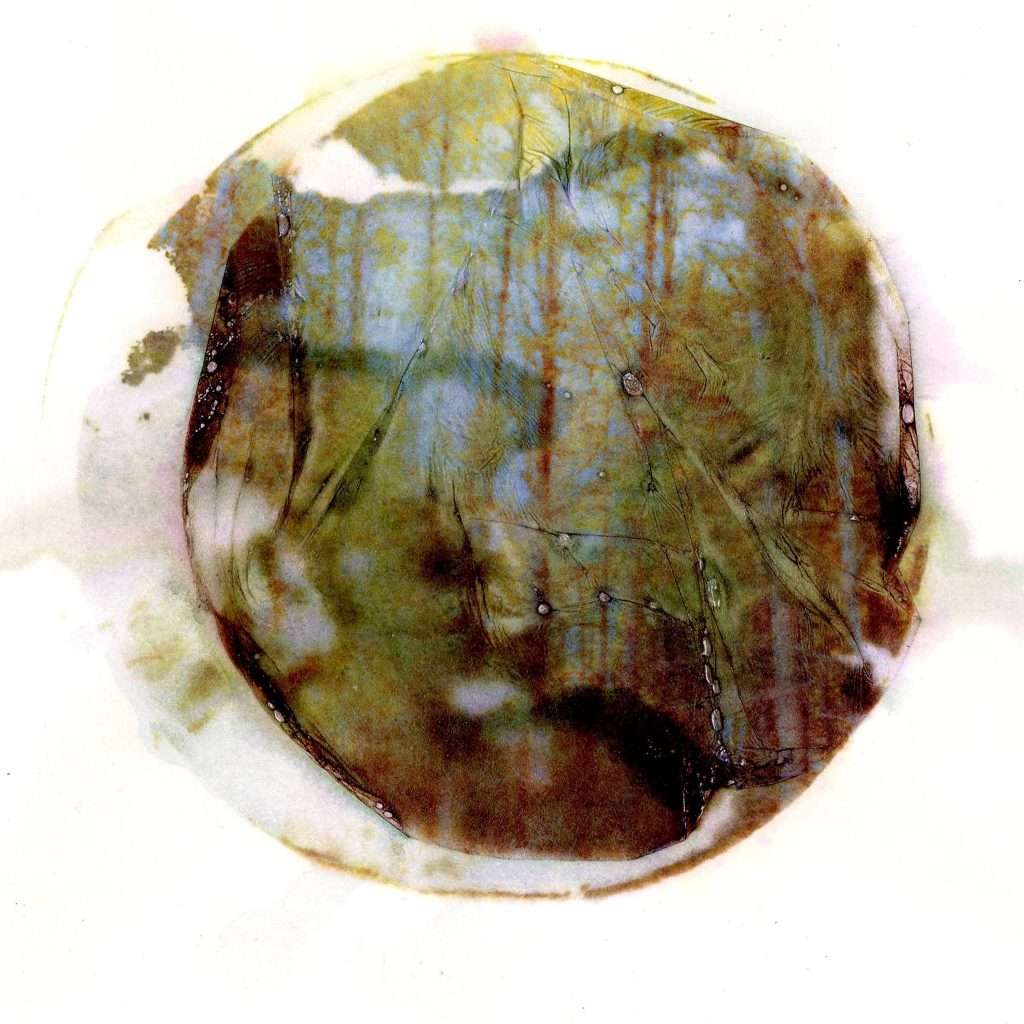
Cree Tylee – Femme Folks Fest Repost
March 17, 2022Cree Tylee ``...now I am rampant with memory....`` The COVERT Collective is pleased to be participating in Femme Folks Fest 2022. Today... Read More

Gabrielle de Montmollin | Weird Baby World – Femme Folks Fest Repost
March 14, 2022Gabrielle de Montmollin’s installation Weird Baby World is both engaging and eerie, employing iconography that is evocative and somewhat unsettling. Bart Gazzola offers a response to this street level exhibition, on display at Niagara Artists Centre (NAC) in St. Catharines.
Read More
Gabrielle de Montmollin | Weird Baby World
August 13, 2021Gabrielle de Montmollin’s installation Weird Baby World is both engaging and eerie, employing iconography that is evocative and somewhat unsettling. Bart Gazzola offers a response to this street level exhibition, on display at Niagara Artists Centre (NAC) in St. Catharines.
Read More
Cree Tylee
April 9, 2021Cree Tylee ``...now I am rampant with memory....`` To be honest, and all the external influences aside, there are some parts... Read More
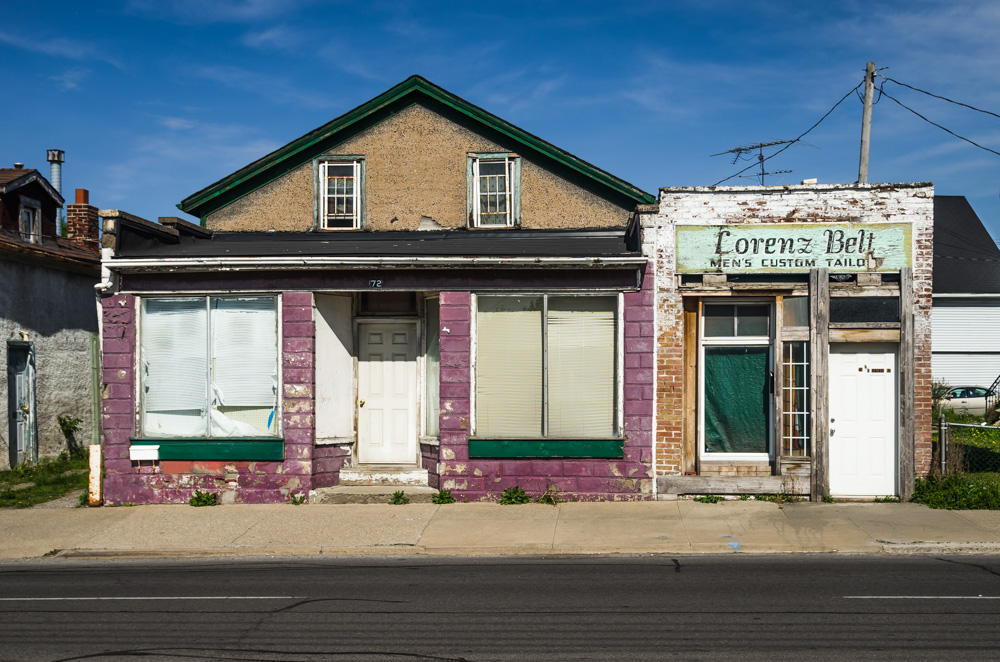
Recent Comments